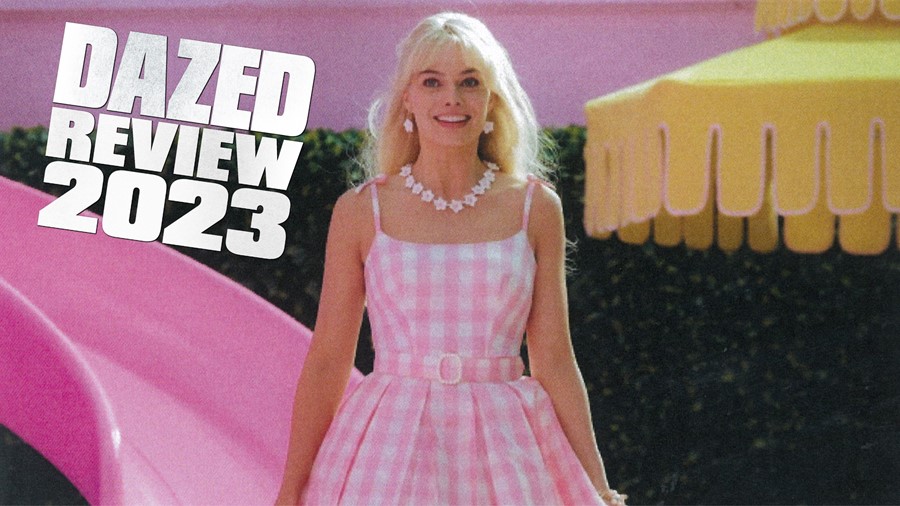From Barbie to the Eras Tour to girl dinner, girliness and girly aesthetics have dominated pop culture this year – but why?
Girldom has dominated pop culture this year. The tomato girl, rat girl, strawberry girl, feral girl, clean girl, have all had their moment in the spotlight on TikTok, while even the most mundane aspects of our lives have become girlified too. Perhaps you’ve been on a ‘hot girl walk’ or considered packing in your corporate career for a ‘lazy girl job’, danced to ‘It Girl’, done some ‘girl math’ to justify your Black Friday purchases, or tucked into a ‘girl dinner’. Girliness isn’t exclusive to girls either (young, female-identifying): everyone and anyone can be a girlie.
We reached peak girl this year in July, when a hot pink tsunami descended to see Greta Gerwig’s Barbie, turning the film into a billion-dollar blockbuster within weeks of its premiere and earning Gerwig the title of the highest-grossing female director of all time. Meanwhile, Taylor Swift crashed Ticketmaster for her sold-out world tour, smashed box office records with the Eras Tour film, and became the first ever artist to earn $1 billion from a single tour. Named Time’s Person of the Year, Swift has been a pivotal figure in this resurgence of girlhood, encouraging other women to reflect on the “woods we’ve wandered” by re-recording her albums from her (and our) youth.
Elsewhere, film directors have captured the vast spectrum of girlhood: from the carefree, excitement of your first bra in Are You There God? It’s Me, Margaret to the nuances of consent in How to Have Sex, to the all-too-common experience of losing your identity in straight relationships in Sofia Coppola’s Priscilla. Hyper-femme fashion trends have been on the rise too, with brands festooning pieces with feminine bows, ribbons, ruffles and frills: take Sandy Liang’s AW23 show, where models wore their hair interwoven with tiny, delicate bows.
“I really feel like women crave the innocence of childhood, frivolity and childishness because it’s taken away from us too soon,” says Oenone Forbat, host of the Adulting podcast and author of Bad Influence. “We were taught that ‘girlishness’ was a bad thing, so it’s really fun and comforting to indulge in something a lot of us maybe feel like we shunned or couldn’t access in our adolescence.”
Taya Miller, an influencer with over five million followers, agrees. “This resurgence in girl trends means no longer being ashamed of the parts of me that I tried to suppress for so long,” Miller says. “I’ve accepted the little girl in me that waited 24 years to be herself, fully and authentically.” Growing up, when it “wasn’t cool to be girly”, Miller admits she suppressed certain interests – namely her love of comic books and Taylor Swift – which she’s reconnected with through content creation to live out her “girlhood dream of being an influencer.”
Admittedly, culture’s fascination with girlhood is nothing new. Take Jeffrey Eugenides’ 1993 novel The Virgin Suicides, which delved into anxieties about girlhood, or Sylvia Plath’s 1963 work The Bell Jar, which railed against the ways society limits young women (and how it drives them mad in the process). Notably, over the summer, writer and editor Claire Marie Healy worked with The Tate to curate a selection of portraits that examined depictions of girlhood in art, which traced depictions of girls from 26-year-old photographer Rene Matić’s modern day photographs all the way back to the pre-Raphaelite era.
“Key milestones that previously signified womanhood like marriage and having kids are being delayed, so our twenties have become a period of extended girlhood but with more capital to enjoy it” – Deanna Middleton, strategist at The Digi Fairy
But what is it about 2023 that has triggered girldom to dominate film, music, fashion, and the internet at large? Sure, Sofia Coppola’s 2000 adaptation of The Virgin Suicides left an indelible mark on culture but it was only the 148th highest-grossing film of 2000 – a stark contrast to Barbie and Taylor Swift’s Eras Tour film, which came in at #1 and #20 respectively on the list of the highest-grossing films of 2023. “The period from girlhood to womanhood is being extended. Key milestones that previously signified womanhood like marriage and having kids are being delayed, so our twenties have become a period of extended girlhood but with more capital to enjoy it,” Deanna Middleton, a strategist from creative agency and internet culture specialist The Digi Fairy explains.
“Historically, women had to take on masculine traits like lowering their voice or power dressing to be taken seriously but now women are embracing hyper-femininity as a form of empowerment,” she continues. “A lot of women are reckoning with internalised misogyny and are reclaiming the ‘girly’ aesthetics they previously deserted to get ahead in our patriarchal system.” Additionally, women are also grappling with the fallout of the fall of Roe v Wade in the US, a cost-of-living crisis, and relentless gender-based violence, including a litany of disturbing allegations against high-profile men such as Russell Brand and P Diddy. “Returning to girlhood favourites like cartoons, games and toys offers comfort and familiarity in times of distress. The movement is creating a global support network where women can speak about the unique experience of being female, helping each other to feel seen and comforted in our turbulent world,” Middleton adds.
Could the rise of girliness be a feminist force for radical change? Perhaps not, especially when so many ‘girly’ trends are fundamentally capitalistic and are just encouraging us girlies to buy more products (if we want to look at it cynically, Barbie was one big Mattel advert). That said, girl trends are an opportunity for women to fulfil their need to be playful in a hectic and demanding adult life – and could actually have political potential. Dr Victoria Cann, professor in gender politics and feminist theory at University of East Anglia and author of Girls Like This: Boys Like That, explains that “work on Black girlhoods from thinkers like Aria Halliday highlight that the label and concept of ‘girl’ is routinely used within Black femme communities lovingly and as a source of affirmation,” and adds that within queer subcultures read femmeness “as having resistant potential [...] whereby alignment with femme becomes an act of resistance against a heterosexist culture.”
Additionally, though many recent girl trends insist that we’re ‘just girls’ with brains as smooth as Barbie dolls who are fundamentally incapable of taking anything seriously, Cann suggests that in “a patriarchal world that devalues the feminine” anything that leans into the “pleasures of femininity… is always a point of political resistance.” In any case, whether girl trends leave any meaningful impact on society and culture or not, no one can say that it’s not been fun. “Every woman deserves to feel like a little girl – free, creative and wild,” Miller says. “Even if it’s a little late.”




